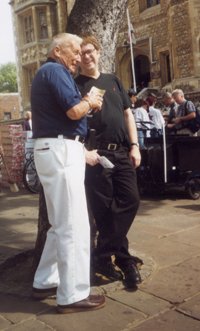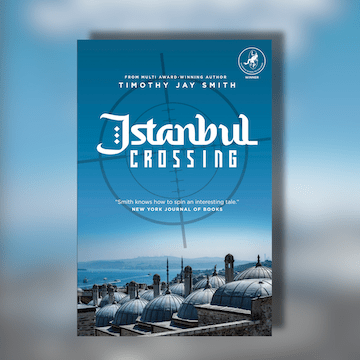 As we reported on Crime Fiction Lover, Max Allan Collins is the literary executor of Mickey Spillane and has completed the lost second Mike Hammer novel, Lady, Go Die! for publication. The book was originally written by Spillane in the late 1940s after I, the Jury. It’s not the first time Collins has filled in the gaps so that we can enjoy a missing Hammer, and he’s a much lauded author in his own right. With Edgar and Shamus awards under his belt, he’s the man behind the Nathan Heller and Eliot Ness novels, and even created a CSI novelisation. Lady, Go Die! sees Mike Hammer and his secretary Velda head to Long Island for a weekend break, but the detective is soon drawn into a murder case when a woman’s naked body is discovered astride the statue of a horse.
As we reported on Crime Fiction Lover, Max Allan Collins is the literary executor of Mickey Spillane and has completed the lost second Mike Hammer novel, Lady, Go Die! for publication. The book was originally written by Spillane in the late 1940s after I, the Jury. It’s not the first time Collins has filled in the gaps so that we can enjoy a missing Hammer, and he’s a much lauded author in his own right. With Edgar and Shamus awards under his belt, he’s the man behind the Nathan Heller and Eliot Ness novels, and even created a CSI novelisation. Lady, Go Die! sees Mike Hammer and his secretary Velda head to Long Island for a weekend break, but the detective is soon drawn into a murder case when a woman’s naked body is discovered astride the statue of a horse.
Since interviewing Mickey Spillane live at Bouchercon in 1980, Collins became good friends with this king of hardboiled as well as an expert on his work. As Lady, Go Die heads towards its UK release on 25 May 2012, we asked Max Allan Collins what it was like to work on such an incredible project.
Why do you think Mickey Spillane never completed this novel for publication? It has such a strong story line.
I never discussed it with him, but I believe it probably got set aside when he realised he wasn’t going to get another Mike Hammer contract from his publisher. The first Hammer, the very famous I, the Jury, was something of a flop in hardcover. It was in paperback that it set the world on fire. That’s why I, the Jury came out in 1947 and the next Hammer, My Gun is Quick, in 1950. I also think he may have felt he was getting Hammer and his secretary Velda too close to the altar too soon. The book has them on a weekend getaway, after all.
 When you finished The Goliath Bone and The Big Bang, there seemed to be a seamless transition between Spillane’s text and your own. It’s the same with Lady, Go Die! How have you managed to achieve this?
When you finished The Goliath Bone and The Big Bang, there seemed to be a seamless transition between Spillane’s text and your own. It’s the same with Lady, Go Die! How have you managed to achieve this?
It’s more a case of writing in character. These are first-person books, after all. The more subtle aspect is that I try to make each book feel like Mickey had completed it in the year he began it. By that I mean I study the adjacent books in the series to capture the right tone. In Lady, Go Die! for example, you will find no four-letter words – because he began it in the late 40s. Now in The Goliath Bone, The Big Bang and Kiss Her Goodbye, you’ll find the f-word and much more, reflecting both the era and Mickey’s own writing of the period. We are filling in spaces in the canon.
What are some of the challenges you faced with Lady, Go Die!?
This manuscript began at chapter two; Mickey’s chapter one long missing. So I had to write the first chapter by myself, which was a first. Mickey was famous for strong opening chapters. My process is not to pick up where Mickey left off, but to treat the material as rough draft and shape it and expand and extend it, weaving my own writing in and around Mickey’s. That’s why when the Mickey stuff gives out, maybe two-thirds of the way, the transition is so smooth.
I, The Jury was notorious for its shocking conclusion, back in the day. But by today’s standards Spillane’s writing may seem more tame. Is this a concern?
Mike Hammer continues to entertain because the character is so strong, so much the embodiemnt of this classic genre figure, the private eye. But the books have not lost their potency. Yes, the sexual content seems less shocking, but the violence can still make your hair stand on end. Spillane’s visceral approach to action scenes, which I am pretty good at myself, is a key element of the enduring success of these novels and this character.
 You are working with Titan Books on a couple more Spillane treats. Can you give our readers a glimpse of what to look forward to?
You are working with Titan Books on a couple more Spillane treats. Can you give our readers a glimpse of what to look forward to?
Complex 90 is set in the mid-60s and has Hammer going to Russia initially, then returning to Manhattan in what is a sequel to his well-known novel, The Girl Hunters. King of the Weeds was the Hammer Mickey worked on in the 80s and 90s, intended to be the last Mike Hammer book until 9/11 happened and he decided to write The Goliath Bone. It’s about a serial killer attacking cops. There are three more significant if somewhat shorter Hammer manuscripts after that, if the public maintains its interest. The fun part about that final trio is they are all 1950s stories, when Hammer is at his best.
Finally, could you tell us which author, living or dead, you would nominate as your own literary executor?
I don’t have the stockpile of unpublished material that Mickey did. It would probably be a single novel that I dropped dead in the middle of. My wife Barb will know what to do. If she can’t finish it herself, there’s Matt Clemens, plus my buddies Ed Gorman and Steve Mertz who she would turn to. I’ll let Hammett, Chandler and Mickey rest in peace.








